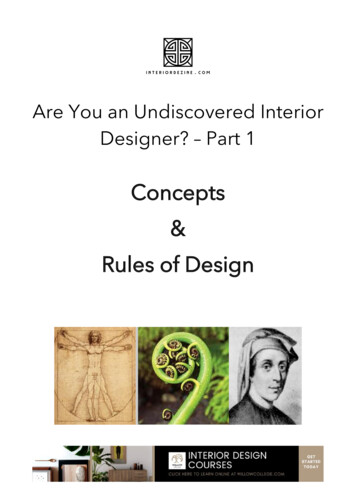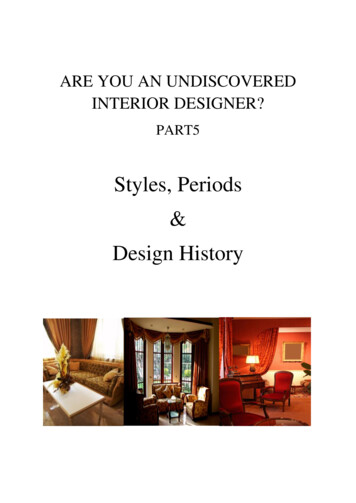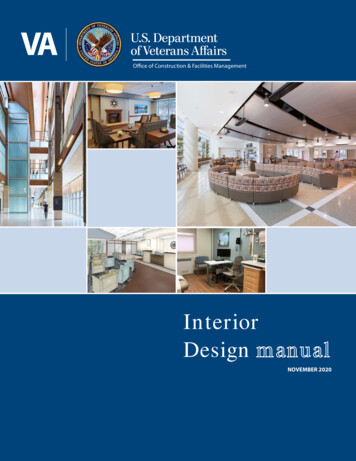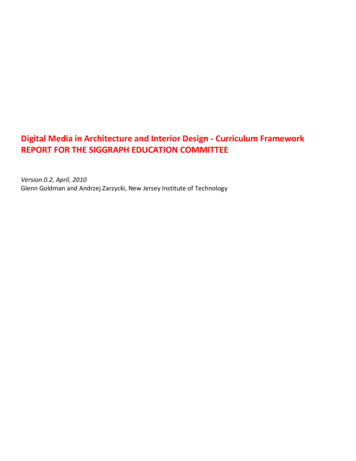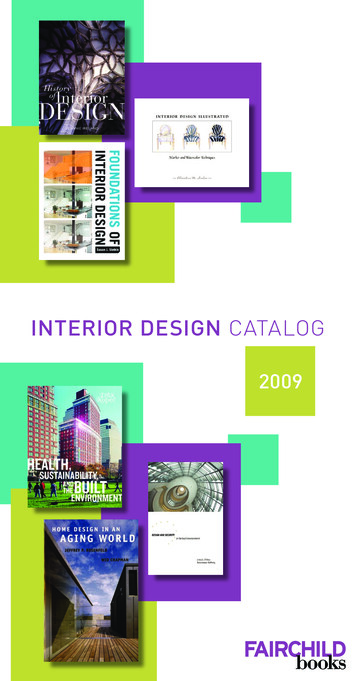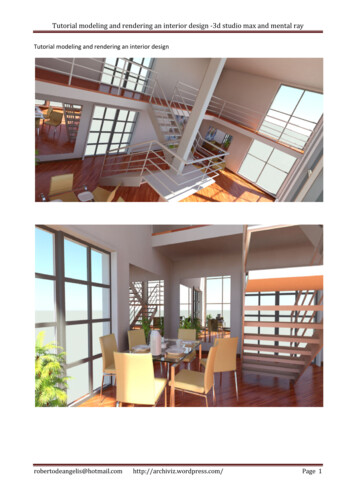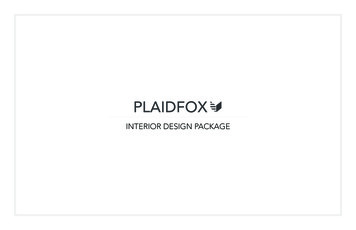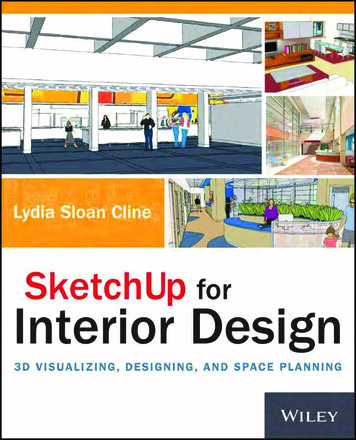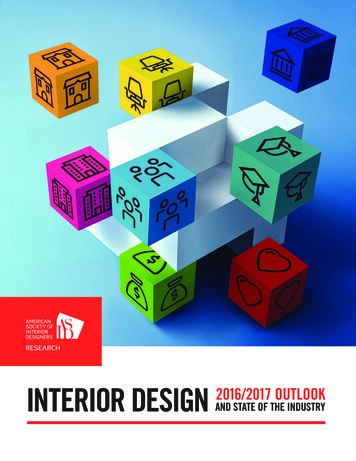
Transcription
INTERIOR DESIGN2016/2017 OUTLOOKAND STATE OF THE INDUSTRY
2016/2017 OUTLOOK AND STATE OF THE INDUSTRYTABLE OF CONTENTSEXECUTIVE SUMMARY 2STATE OF THE INDUSTRY 4OVERVIEW 7FACTORS AFFECTING THE DESIGN PROFESSION 9FACTORS AFFECTING THE DESIGN PROJECT 14KEY FACTORS IMPACTING INTERIOR DESIGN 18Global IssuesThe Economy 20Environmental Protection 23Security 25Culture/ValuesGenerational Differences 27Well-being 29Community 31Design Excellence 33Business of DesignFirm Structure 35Data & Knowledge 37Time 39Value Proposition 41CHANGEMAKER CHALLENGE 43Steps toward DivergenceSteps for ConvergenceACKNOWLEDGMENTS 46ASID INTERIOR DESIGN 2016/2017 OUTLOOK AND STATE OF THE INDUSTRY1
EXECUTIVE SUMMARYAt ASID, we know that interior design impacts the human experience.Effective interior design makes workers more efficient, helps students learn,and helps everyone get and stay healthy; it helps us have fun, age gracefully,and connect with family. Design is at the crux of how we live, work, and play.But if this is how interior designers impact the world around us, what impactsinterior designers? When we sit down at the drafting table, what factors areat play? And how do they impact the designs we ultimately produce? Forthe 2016/2017 Interior Design Outlook and State of the Industry report, wehypothesize that in order to understand the built environment, where wespend about 93 percent of our lives, we must first understand what impactsthe people who design it.Using input from industry thought leaders, educators,and specialists across the design sectors, we’veidentified key factors at global, national, and industrylevels that affect the profession, and organized themaccording to their degree of impact on designers asindividuals, and on their projects. Though open tointerpretation, our Think Tank Challenge participantsranked categories of business environment, traits ofthe individual designer, knowledge, and generationaldifferences as high-impact factors affecting the designprofessional. The sociopolitical landscape, scienceand technology, innovation, and morality/ethics appearto have a medium impact. Meanwhile, the regionaland global contexts have low but persistent impactson designers. When considering factors that affect agiven project, the groupings and degree of impact shiftslightly, but the factors are essentially unchanged.Beyond identifying factors and ranking themaccording to impact, we also discussed how eachone affects design, and whether its impact is likelyto rise or fall over the next three to five years. Severalinteresting connections became apparent, such asthe link between the perceived value of design, timepressure, and the possible downward trajectory ofdesign excellence. But while there are pressures thatnegatively affect design, we also heard about a crosscurrent of innovation, and a breakdown of silos thatis elevating the profession. We also found complexlinkages between community, generational differences,and a push toward well-being through design thattogether are reshaping how we think about space.The factors affecting design, and thus the world aroundus, are complex and changing. Indeed, it seems thatASID INTERIOR DESIGN 2016/2017 OUTLOOK AND STATE OF THE INDUSTRY2
EXECUTIVE SUMMARYwe are not only in a period of tremendous change forboth the business and practice of design, but the paceof change is accelerating, with no signs of slowing. Thiscomplex, dynamic, and accelerating environment isdifficult to navigate, but we close each section and thereport as a whole by challenging ASID members andthe broader design community to proactively push theboundaries that box us in, to form new connections,and to demonstrate the impact of design.Whatever factors may be at work, they have conspiredto make the business of design quite good over the past12 months, and we expect that to continue. Last year’sState of the Industry report showed that interior designhad fully recovered to pre-recession levels, and themomentum carried through this year, with only slightmoderation. According to the U.S. Bureau of LaborStatistics and the U.S. Census, the number of interiordesigners has grown by 11.9 percent to 68,067, andthe number of firms has grown by nearly 6 percent to12,642. Construction spending is up over last year,with 8 percent growth in residential, and 9 percent innonresidential. Designers remain optimistic about theoutlook, and this has translated into a hot job market,with 29 percent of firms looking to hire this year(up 4 percent from last year).“ INTERIORDESIGN IS ASTRONG ANDGROWINGSECTOR.”Interior design is a strong and growing sector. It’scomplex, changing, and accelerating, but ASID ishelping its members and the broader design communitynavigate the changes by providing them with resourcesthat give them an enhanced understanding of the builtenvironment, and empowering designers to use thefactors that affect design to our advantage.ASID INTERIOR DESIGN 2016/2017 OUTLOOK AND STATE OF THE INDUSTRY3
STATE OF THE INDUSTRYThe business of interior design has been quite good over the past 12 months,and we expect that to continue. Last year’s State of the Industry reportshowed that interior design had fully recovered to pre-recession levels, andthe momentum carried through this year, with only slight moderation. Withall indicators showing robust growth, this is a good time to be in the interiordesign business.68,067EMPLOYED INTERIOR DESIGNERSSource: U.S. Bureau of Labor Statistics, Occupational EmploymentSurvey, and Labor Force Current Population Survey12,642TOTAL NUMBER OF DESIGN FIRMS(INCREASE OF 6 PERCENT)Source: U.S. Bureau of Labor Statistics, Census of Employment and WagesUP 7,243 SINCE 2015TOTAL # OF DESIGNERS (INCREASE OF 11.9 PERCENT)Source: U.S. Bureau of Labor Statistics, Current Employment Survey29 PERCENTOF FIRMS LOOKING TO HIRE THIS YEAR(INCREASE OF 4 PERCENT) 9.1 BILLIONVALUE OF SALES (0.6 PERCENT GROWTH)Source: Barnes Reports, 2016 U.S. Industry Market Report, Interior DesignServices IndustrySource: ASID Business Performance SurveyASID INTERIOR DESIGN 2016/2017 OUTLOOK AND STATE OF THE INDUSTRY4
STATE OF THE INDUSTRYCONSTRUCTION SPENDING IS STRONG2016 Q1( M)% change from2015 Q1 to 2016 Q1TOTAL RESIDENTIAL.435,484. 8%New Single Family.236,274. 13%New Multifamily.64,427. 35%Home Improvement.147,884. 9.7%TOTAL NONRESIDENTIAL.406,849. 9%Lodging.23,235. 29%Office.55,218. 24%Commercial/Retail.70,382. 13%Manufacturing.79,328.- 2%Healthcare.32,065. 6%Educational.19,119. 22%Religious.3,359. 6.7%Amusement/Recreation.11,009. 30%Transportation.14,798. 11%COMMERCIAL/INDUSTRIALINSTITUTIONALMillions of DollarsSeasonally Adjusted Annual RateSource: U.S. Census Bureau, Value of Construction Put in Place: Construction SpendingASID INTERIOR DESIGN 2016/2017 OUTLOOK AND STATE OF THE INDUSTRY5
STATE OF THE INDUSTRYU.S. INTERIOR DESIGNERSU.S. DESIGN FIRMS9% GROWTH PROJECTED FOR 20164% GROWTH PROJECTED FOR 2016Employed Interior DesignersNumber of Interior Design FirmsSources: U.S. Bureau of Labor Statistics and Labor Force CurrentPopulation Survey thru 2015; ASID projection for 2016Sources: U.S. Census County Business Patterns thru 2015; ASIDprojection for 2016YEAR-OVER-YEAR PERCENTAGE CHANGE IN NEW RESIDENTIALCONSTRUCTION PERMITS BY METROPOLITAN AREA, 2016 Q1KEYLess than -50%-50% to -21%-20% to -1%01% to 20%21% to 50%Over 50%Source: ASID, using data from U.S. Census BureauVISIT ASID.ORG/OUTLOOK2016 FOR A FULLY DYNAMIC, INTERACTIVE MAPASID INTERIOR DESIGN 2016/2017 OUTLOOK AND STATE OF THE INDUSTRY6
OVERVIEW:ASID INFLUENCE ANALYSISFor the 2016/2017 Interior Design Outlook and State of the Industry report, we hypothesize that inorder to understand the built environment, where we spend about 93 percent of our lives, we mustfirst understand what impacts the people who design it.To test our hypothesis, we held a Think Tank Challengewith six thought leaders who have their fingers on thepulse of what is happening in the overall interior designprofession through their work on design projects,publications, and design/business consultancies1.The Think Tank Challenge kicked off with participantsbrainstorming a list of key factors each thought wereimpacting the interior design profession at the global,national, industry, and business scales. Factors wereedited, combined, and added as the discussion wenton. Participants were then asked to consider an interiordesigner sitting at their desk preparing to begin anew design, and then rate how much each factoraffects them (i.e., high, medium, or low), and perhapsmore importantly, how, or in what ways, the factorimpacts the designer and the work they produce. Thenparticipants voted on whether they expected certainfactors to increase or decrease in impact over the nextfew years. The height of the discussion was reachedwhen participants took on the challenge of rethinkingwhat the profession should do moving forward toaddress the factors impacting us in this constantlychanging world.To dig deeper, we then held six sector-specificdiscussions with designers specializing in residential,office, healthcare, hospitality/retail, and education/government design, as well as with design educators2.We asked each to independently create a list offactors they believe impact interior design, and thenexamined each further. In addition, we surveyed over100 practicing interior designers from various designsectors and asked them to rate the key impact factorsidentified at the Think Tank Challenge. Again, we askedwhich factors have the most impact, and if they believethe influence of each will grow or wane in the next fewyears. Some of this rich knowledge was weaved into thisreport, but to do it justice, we’re planning to publishseparate sector briefs during the latter half of 2016.1Bob Fox, Work Design Magazine; Jill Goebel, Gensler; Reed Kroloff, Jones Kroloff; Vincent Ng, HOK; Christopher Ramey, Affluent Insights; SusanSzenasy, Metropolis2See Acknowledgments for full list of participantsASID INTERIOR DESIGN 2016/2017 OUTLOOK AND STATE OF THE INDUSTRY7
OVERVIEWThe content in this report is an amalgamation of these discussions, surveys, and the results of an ASID literaturescan to better grasp the complex, interconnected world of interior design. Here are a few key takeaways:IT’S COMPLICATEDFactors that affect interior design evoke “big-bucket” words like “Economy,” “Environment,” “Time,” and“Generational Differences.” Once you start to unpack them, they fill your head with nearly limitless depthand breadth of meaning. The complexity of these forces and their interaction with design intertwine with theincreasingly complex problems interior designers are being asked to solve. As we learn about the forces behindthose problems, we begin to see just how intricately woven they are. In this complicated world, exploring andseeking to understand the factors that shape interior design can lead to advances in business and the profession.IT’S DYNAMICWe live in a world of change where nothing stays the same. Just when you think you’ve got a grasp on how torun an interior design business and how to solve modern problems through elegant use of space, the businesslandscape shifts, or the problems change. The changes in one area also impact related factors, both directly andindirectly, and the constant interactions among them keep the dynamics changing as well. The only thing thatstays the same, it seems, is the fact that nothing [else] stays the same.THE PACE OF CHANGE IS FAST AND GETTING FASTERNot only is change constant, but the pace of change is also fast and increasing. The rate at which new scientificunderstanding emerges, and new technologies hit the market is fast, and increasing, with no signs of slowingdown. Humanity’s understanding of our biology and psychology, and how those things interact with the physicalworld, is growing exponentially. New advances, such as the technology available to designers – from BIM softwareto 3D printing, and even the flow of information via social media are evolving relentlessly, and can affect howwe design, or how we should design, space. As digital natives (people who were brought up in the age of digitaltechnology) become increasingly established in the workforce, we can expect the rate of change to keep rising.WE HAVE THE POWERThe complex, changing, and accelerating world may seem overwhelming, especially when we’re looking forstability in our business and are tasked to come up with design solutions that will last. It would be easy to ignorethe complexities and the changes and instead focus on what we know, or rather what we think we know, stickingwith the business and design solutions that have worked for us in the past. But those who do that, either firms orindividual designers, risk getting left behind. ASID believes that although the factors that impact design are biggerthan any one firm or individual, we are not at their mercy. We can be proactive, we can effect our own change, andwe can take advantage of the changes that come our way. Interior designers are in a unique position to change theworld around us. We create places that make people efficient, help them learn, help them get and
ASID INTERIOR DESIGN 2016/2017 OUTLOOK AND STATE OF THE INDUSTRY 2 At ASID, we know that interior design impacts the human experience. Effective interior design makes workers more efficient, helps students learn, and helps everyone get and stay healthy; it helps us have fun, age gracefully, and connect with family. Design is at the crux of how we live, work, and play.
